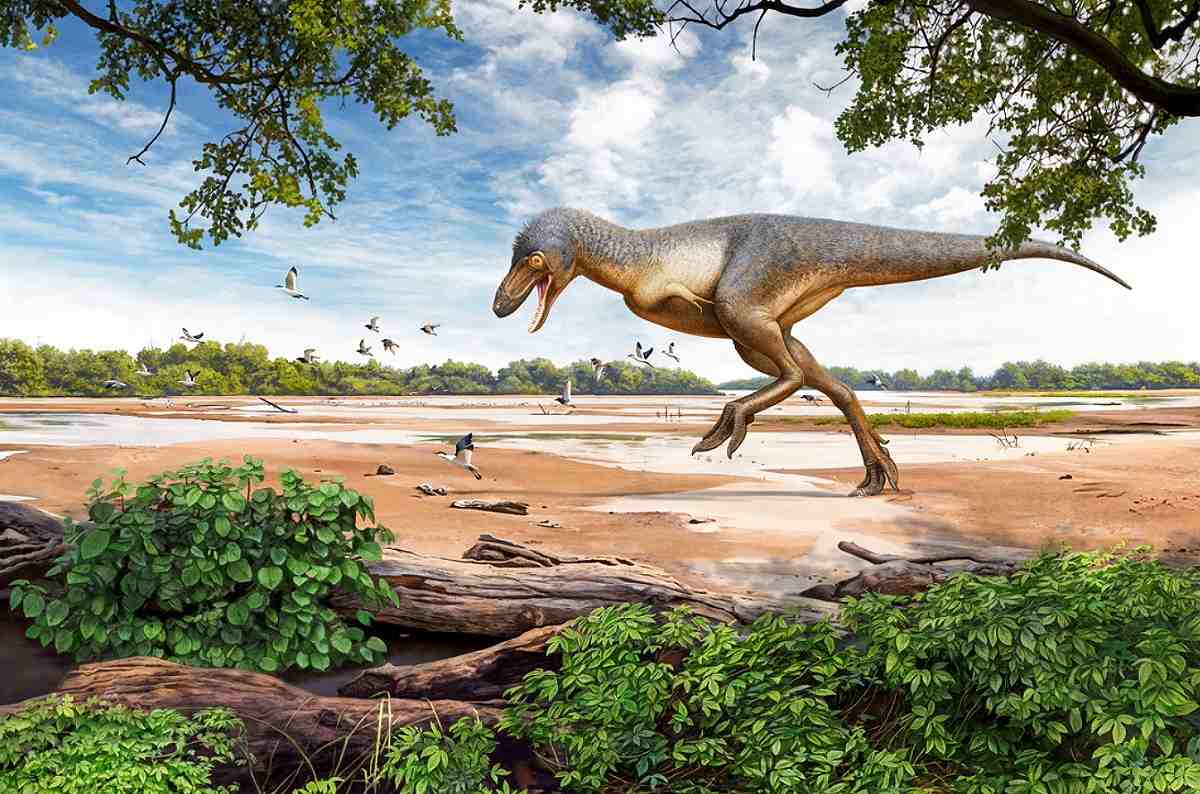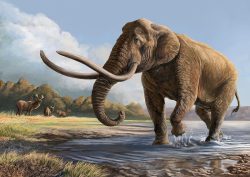
The 67 million-year-old Cretaceous Period landscape of North Dakota with a juvenile Tyrannosaurus rex is seen in this illustration.
15:54 JST, June 15, 2024
A rare fossil of an adolescent Tyrannosaurus rex has been excavated in North Dakota’s badlands — a find noteworthy for the scientific insight it may offer into the life history of this famous dinosaur and for the tale of the kids who found it.
The discovery of the fossil, nicknamed “Teen Rex,” was announced on June 4 by the Denver Museum of Nature & Science, where it will be studied and displayed.
In July 2022, brothers Liam and Jessin Fisher, 7 and 10 at the time, and their cousin, Kaiden Madsen, who was 9, were hiking and looking for fossils with Sam Fisher, father of Liam and Jessin, on land managed by the U.S. Bureau of Land Management about 16 kilometers from the town of Marmarth in southwestern North Dakota. Liam and his father noticed a large leg bone sticking out of the ground.
“My dad hollered for Jessin and Kaiden to come, and they came running,” said Liam, now 9. “And dad asked, ‘What is this?’ And Jessin said, ‘That’s a dinosaur.’”
“I didn’t know what type,” said Jessin, now 12.
Sam Fisher texted a picture to paleontologist Tyler Lyson, a Marmarth native and his former high school classmate who now is curator of vertebrate paleontology at the Denver Museum of Nature & Science. Lyson obtained excavation permits, and in July 2023 everyone returned to the site.
Initially, it appeared that the leg belonged to a plant-eating duckbilled dinosaur.
“However, on day one of the excavation, Jessin and I uncovered the lower jaw with several big T. rex teeth sticking out of it,” Lyson said.
“It still gives me goosebumps,” Lyson added.
“I was completely, like, speechless,” said Kaiden, now 11.
Tyrannosaurus, which roamed western North America, was one of the largest meat-eating dinosaurs.
It appears this Tyrannosaurus was about 13-15 years old, two-thirds adult size, 7.6 meters long and 1,600 kilograms. T. rex was fully grown at around 18-21 years. Perhaps the largest-known Tyrannosaurus, a specimen named Sue at the Field Museum in Chicago, is 12.3 meters long.
This individual lived about 67 million years ago, near the Cretaceous Period’s end. Tyrannosaurus and the rest of the dinosaurs, aside from their bird descendants, were wiped out 66 million years ago after an asteroid struck Earth.
The fossil comes from the Hell Creek Formation region that “preserves Earth’s last dinosaur ecosystem” right before the mass extinction, Lyson said. Based on the soft sandstone in which it was found, the animal’s body apparently ended up on a sandbar in an ancient river system.
The completeness of the skeleton remains unclear because a lot of the bones remain embedded inside a three-ton chunk of rock, now being studied at the museum. It appears there is a lot of the skull, the hipbone and some vertebrae in addition to the leg, Lyson said.
Tyrannosaurus had a massive head and tremendous bite force, walked on two legs, and had puny arms with just two fingers. A younger Tyrannosaurus had a different body type than an adult — more gracile and speedier, and with a skull that was more streamlined — and may have hunted different prey, reducing competition with its elders.
“Juvenile T. rexes were much more lightly built, with long gangly legs, but without the large mass of adult T. rexes,” Lyson said.
Having juvenile specimens helps reveal the Tyrannosaurus growth rate and body changes during maturation, Lyson said. Only a handful of such fossils are available for study. It appears this one is slightly larger than another juvenile Tyrannosaurus fossil called “Jane” at the Burpee Museum of Natural History in Rockford, Ill., Lyson said.
A minority of paleontologists think Tyrannosaurus lived alongside a smaller cousin called Nanotyrannus, based on fossils that most paleontologists believe represent Tyrannosaurus juveniles. Lyson said the new fossil could shed light on that issue.
A documentary crew was present during the excavation, with the film “T. REX” set to be released on June 21.
"Science & Nature" POPULAR ARTICLE
-

‘Fiercest, Most Damaging Invasive Weed’ Spreading in Rivers, Lakes in Japan, Alligator Weed Found in Numerous Locations
-

Univ. in Japan, Tokyo-Based Startup to Develop Satellite for Disaster Prevention Measures, Bears
-

Tsunami Can Travel Vast Distances Before Striking, Warn Japanese Researchers
-

Japan’s H3 Rocket Failed in Latest Launch, Says Official
-

Japan’s H3 Rocket Likely Made 1.5 Trips Around Earth; Analyst Believes Satellite Almost Certainly Lost As Well
JN ACCESS RANKING
-

Japan Govt Adopts Measures to Curb Mega Solar Power Plant Projects Amid Environmental Concerns
-

Core Inflation in Tokyo Slows in December but Stays above BOJ Target
-

Major Japan Firms’ Average Winter Bonus Tops ¥1 Mil.
-

Tokyo Zoo Wolf Believed to Have Used Vegetation Growing on Wall to Climb, Escape; Animal Living Happily after Recapture
-

JAL, ANA Cancel Flights During 3-day Holiday Weekend due to Blizzard
























